Family time is good for the 'Seoul.'
Our trip started with a good ole ginseng-themed stop on the drive up. Rest stops are busy little hubs with, of course, a gas station and clean rest rooms. They are also teemed with trinket shops, donut shops, sometimes a clothes store, a Korean restaurant, a convenience store (maybe a GS25, an Emart 24 or a CU), and all kinds of fried Korean carni-snacks. They are themed with something that each local area is known for.
This stop is all about ginseng. I have never seen ginseng when it is still in the ground, but apparently is has a pretty little flower up top.
When we drove into Seoul we were greeted with the riot brigade. A little disconcerting for our very first visit to the big city. However, I think they were just out for a little training. We saw police throughout the week, but the city was safe and thankfully there were no riots.
Upon arrival to our hotel we learned that we had to have some type of covering over our heads in the swimming pool. This isn't our first Korean swimming pool rodeo, so we should have remembered that form last summer. But we didn't, so we walked to the nearest Lotte Mall, which wasn't very far away, to grab dinner and a hat.
I wish my kids liked to wear baseball caps.
Daddy opted for an actual swim cap, but the rest of thought we would use a baseball cap more often, knowing full well that we rarely wore the cap we purchased a year ago.
Momma holding all three of her babies at once.
The next day we had a tour scheduled. We started with a taxi going to the N Seoul Tower. The dude dropped us off on the back side, explaining why but we couldn't understand. We found this cute little statue to replicate though.
The front side of Mt. Naman has the gondola ride up. The most we could figure out was that the gondolas were not running due to the rain? I guess the taxi driver was telling us that was why he dropped us off on the back side of the mountain. Even though visibility wasn't good for the tower view, we started the trek up anyway.
The Hanyangdoseong Wall was built more than 500 years ago during the Joseon era to protect the
capital city, then known as Hanyang. The city was surrounded by four mountains: Baegan (N), Naksan (E), Namsan (S), and Inwangsan (W), and it was constructed along the ridges of these mountains. Apparently some of the blocks along the wall have inscriptions that express the culture and artistic taste of the residents of that time, but I did not see any of those.
Access into the old capital was limited to four major gates and four minor gates, situated in four different directions. The gates were named to reflect four key Neo-Confucian values: benevolence, righteousness, propriety, and wisdom. Two water gates were built into the west wall to allow runoff from the four surrounding mountains to drain out from the city. I think it's cool that they are going engineering stuff hundreds of years ago.
This lookout was about 3/4 of the way up.
I like the forced perspective (which was by total accident); these stairs are ascending, but they look like they are descending.
The weather was not great for viewing the city from above, but it made for a pretty picture.
N Seoul Tower is a popular date spot so it goes without saying that this particular attraction became the site for 'locks of love.' The concept is not unique to Korea, but they have most certainly embraced it wholeheartedly.
Couples, families and friends place their lock with a message in hopes of everlasting love and then deposit the key into a box so the lock will always remain. I saw one lock that was scribbled out; I guess that particular love was not so everlasting.
So. Many. Locks.
The cable car, if you are lucky enough to be able to ride it, dumps you out at the Mongmyeoksan Beacon Hill site.
This area was once called 'Gyeongbongsu,' meaning beacon hill in the capital. The beacon system was used for long-distance communication for the military to warn of attacks. Smoke signals were used during the day and fire signals by night.
Namsan Mountain is a 270m high peak in the center of Seoul, with the tower at the summit.
At this point things were not looking good for our tourism activities for the day. The tour I had scheduled was having issues getting the pass that we needed to go inside the tower. Even if we made it in, the view was not looking too good.
You can't hold a good man nor his family down, so we went inside to explore while I was working things out.
This was the only item on the whole property that specifically asked you to not put locks on.
Souvenir coin!
About now was when the tour for the day was cancelled and we were on our own. The tower wasn't open quite yet so we tried the Ryan Cheezzball Adventure. Kakao is a brand of social media app. Ryan the little bear is the mascot. You see him and his friends everywhere.
It was some sort of 3D adventure so they wore these attractive 3D glasses.
Finally the weather cleared and the tower opened!
For a hot minute I got homesick seeing how far from home we are.
Seoul is massive. The population of the city itself is 10 million; that's even larger than New York City. The whole metropolitan area (~25 million) contains roughly half the population of South Korea.
Just a short bus ride from the Tower we found the Namsangol Traditional Garden.
The garden, pavilions and ponds have been restored to the original terrain because much of it was destroyed at some point in time by Japanese invasions.
A time capsule commemorating the 600th anniversary of Seoul as the new capital was buried 15m underground in 1994. The capsule is shaped like the Bell of Bosingak (Belfry) and contains 600 artifacts that represent Seoul and the contemporary life and culture of Korean citizens. The plans are to open it in 2394.
I was hoping to see Namsangol Hanok Village, but, Covid. Five authentic Hanok (traditional Korean houses) from old were scattered throughout the city and were moved to the gardens in 1993. The houses range from commoners to the most powerful Confucian bureaucrats of the time. This little area was a famous place in Seoul many many years ago, with a pavilion named Cheonugak (blue crane) where clean water flowed. It was believed to be home to both people and blue cranes with supernatural powers.
Next stop was Deoksungung Palace. But again, Covid. It looks like one small building, but behind the wall are several buildings and gardens, right in the middle of the bustling city.
For dinner we ventured to the Harry Potter Cafe. We had walked a lot earlier in the day and decided to drive...parking proved to be a bit tricky.
We made it!
So many choices, but ultimately...
the wand picks the wizard.
Death eater! Or maybe dementor. Who knows.
Cheers to butterbeer!
Be careful of the witching hour--I might hop on my broom and come after you.
He's looking a little Professor Snape-ish.
And the sorting hat says...Dokkaebi!
Our own Hermoine (in more ways that one, my little Type A girl).
Lijee and I have been reading through the Harry Potter series together so it was fun to visit.
Hang on to your hat and your broom.
Turbulence!
Daisy saw these huge ice cream cones as we were looking for parking. When we stumbled upon it on our way back to the car we had to stop. Everything's bigger in Texas Seoul.
Segway for the win! This was our favorite activity. Here we are, practicing before we took off to explore the capital city.
We had a tour guide Harry who led on his bike. He would stop and point out attractions for us.
Daisy and I were in the middle of watching a K-drama called The Eternal King, which has several scenes shot here in Gwanghwamun Square. We were excited to see things from Netflix in person.
This statue is of King Sejong the Great of Joseon during the 15th century. He is the king who invented the Korean alphabet for the commoners to be able to read and write along with the aristocracy. The Gwanghwamun Palace is in the background, as well as Bugaksan Mountain.
Technically we are in front of the Gyeongbokgung Gate. We couldn't tour the actual palace, because, Covid.
This dude is Yi Sun-sin. Yes, I have posted several pictures of him in several places. He's the military genius that defeated the Japanese navy with just a few turtle ships in the late 1500s. There is a fountain back there that I couldn't get a picture of since they weren't on (very typical of Korean water features, to not be turned on). The fountain is called 12.23 Fountain, to commemorate the 12 warships he used to fight 23 battles.
Bukchon means 'northern village' and hanok means traditional Korean home dating back to the Joseon dynasty. Bukchon Village is located north of two significant landmarks, the Cheonggyecheon Stream and Jongo. Today the village consists of cultural centers, guesthouses, restaurants and tea houses, as well as upscale residences. We had to be respectful and quiet as we wandered the streets.
I think this house was one of the previous president's homes.
While we were on the subject of the president's home, Harry took us on a side bar to see the Korean version of the White House, called the Blue House due to the blue tiles on the roof.
We were going by too quickly so I didn't get a picture of the Blue House. Nor did I get a picture of the many military guards holding assault rifles. I was like, "Kids, BE. HAVE!!" Cheongwadae, meaning pavilion of blue tiles, is the official name. Blue House is the most protected official residence in Asia. Of course there are many other buildings in the complex; the entire area covers almost 62 acres.

Here we are driving away. I actually breathed a little sigh of relief that no one misbehaved and got us shot.
Back to the bustling streets away from the quiet streets of Bukcheon Hanok Village and the heavily guarded streets of the Blue House.
This temple is the district head temple of the Jogye order in Seoul, making it the center of Korean Buddhism. It was originally built in the late 14th century but was destroyed by fire; it was rebuilt in 1910 with pine from the Baekdusan Mountain.
Dharma Hall serves as the main venue for several Buddhist events. There was a lotus festival going on, at leaast I think that's what Harry told us. There was a lot of singing and chanting going on. This Chinese Scholar Tree in front is 450 years old. It is 26m (85 ft) high and 4m (13 ft) in circumference.
Lots of potted lotus plants for the festival.
This dude is sitting in front of an ancient lacebark pine called Baeksong, which is said to be 500 years old. One nearby neighborhood is named Susong-dong because 'song' means pine tree. This tree was brought by Chinese missionaries during the Joseon Dynasty.
People leave gifts in front of statues.
This ten-story stone pagoda is home to some genuine relics of some sort.
There are several Buddha statues inside Dharma Hall.
The Beomjongru, or the Brahma Bell Pavilion, houses four instruments that are played before morning and evening chanting. Every day the Brahma Bell rings 28 times in the morning and 33 times in the evening, which is meant to save those from suffering in the world through the dharma. The Dhara Drum, Wooden Fish, and metal Cloud Gong are meant to save those on land, in the sea, and in the sky and space.
People purchase lanterns in memory of their loved ones.
There is always very detailed art on the temples, and they all have the same color scheme.
After stepping out of the temple area, or rather rolling out, we were on the streets of Insa-dong, known for its rich culture.
Lunch time! Our Segway tour included time for a lunch stop, so we had Korean BBQ. Notice all our Segways parked outside.
Lunch was wrapped up with Baskin Robbins from around the corner.
Our tour continued through the Avenue of Youth and on to the Cheonggyecheon area.
Lunch time for this guy too. We saw him jab his beak in the water and grab the fish.
This sculpture is called 'Spring.' The inspiration was from a shell rising up like a pagoda. The height represents the restored vitality of the stream, which was re-developed in the past few decades. The red and blue ribbons show the unit of opposites in nature and the human spirit.
This is the stream referred to. The Cheonggyecheon Stream leads to the Jungnangcheon, which connects to the Han River, eventually feeding into the Yellow Sea. In olden times, ladies would do their washing in this stream.
I•SEOUL•U
The following few days included a bit of business. Zeke and Abe had some appointments so we had to schedule our fun around them.
We moved hotels to a fancy-smancy place in Gangnam connected to the Coex Mall. It was not lost on Daisy that this is the world's largest underground mall. The name is a ship of COnvention Center and EXhibition Hall, along with a couple malls underground.


When you have the pressure of being the world's largest underground shopping mall, you have to make the outside above ground look appealing.
The Starfield Library is located right on the center of the mall. It's a free space to sit down and browse through a book or magazine or use free wifi. Although it is a library, you can only read the books there; they are not to check out. There are plenty of seats to sit down and power outlets to use inside the library. It contains 50,000 titles, but the kids and I were wondering how you could actually get most of those books down.
The City Of Lights exhibit is right in the enter of the library right now (I think it changes out?). The descriptions was some artsy-fartsy talk about the interconnection of space, light, people and knowledge.
The Coex K-Pop Square has lots of decorations and statues.

These hands are for the 2012 hit song
Gangnam Style by Psy, which brought K-Pop to the spotlight. Apparently it is the most watched YouTube video ever, being viewed more than 2.4 billion times.



We were wasting time waiting for the wave LED show to start so they were following the brick lines.
Both these two were getting a little punchy.
Our fancy-schmancy hotel had a gym that hotel patrons could use, but it was also a private gym that outsiders are paying members of. They had fancy changing rooms that had shorts, t-shirts, towels, etc. Abe quickly realized that there is a dress code to use they gym and members are expected to dress in the clothes provided.
One morning we were on a mission to eat pancakes for breakfast. Honestly, the kids and I made it our mission to eat Western food as much as possible whilst in the big city. We were pretty successful.
A little rain did not stop us from finding The Original Pancake House.
It was worth the trek by bus and then walking streets in the rain.
Not exactly singing in the rain. More like waiting in the rain.
It seemed something was lost in translation. However, the eggslut always had a line no matter what time of day we walked by, so I guess it is worth it?
Staying true to ourselves, we enjoyed On The Border one evening. It was super expensive, but the Tex-Mex was oh, so good!
Remember when we went out to specifically buy head coverings to swim in the pool at the last hotel? This place had a head covering policy as well, but they looked at me like I was an idiot when I asked if we could wear ball caps. So we purchased swim hats for the third time in a year. Maybe we will remember to pack them the next time we go to a hotel or swim park, or maybe we will forget and buy another round head coverings.
The children were less than excited when I told them that the Bongeunsa Temple was located just a few blocks from our hotel and we were going to go see it.
I think we all felt like this guy after being stuck at home in quarantine.
More of the lotus festival stuff like the other temple, along with lanterns.
The Jongru, or Bell Pavilion, houses the drum, fish, gong and a bell, just like the Jegyosa Temple. They are also played at dawn and dusk before the ceremonies with the intention of saving all beings.
More memorial lanterns. I would like to learn how long they stay up.
Over 10,000 Buddhists prayed and donated towards
The Great Statue of Maitreya Buddha, erected in the late 1990s. It is the tallest stone statue in Korea at 23m high.
These little bitties have been purchased in memory of loved ones as a permanent fixture, unlike the lanterns that are temporary.
These ladies were practicing traditional dance.
Usually Daddy takes charge on the subway because I am herding the cats, keeping us all safe and together. This particular afternoon we decided to take the subway during Daddy's meeting. Daisy gets a little anxious on the subway anyway, and especially on our first trip without the Pops. The first day we arrived in Seoul we revisited our family policy on what to do if we ever get separated. I think you know where this story is going.
The very first ride we were rushing to make it on the train. Daisy and Eli were on and the doors started to close with Zeke and I on the outside. As I stood desperately looking through the glass doors I could only stand and watch Daisy immediately burst into tears. I was yelling through the doors telling her it would be OK, just get off at the next stop and wait for us. Then I stood helplessly and watched her horror-stricken face disappear as the train zoomed away. Zeke and I looked at each other and simultaneously burst into laughter.
Once we composed ourselves I realized that Daisy could not read my lips about getting off at the next stop because I was wearing a mask. She has a phone with no service, but Korea has a lot of public wifi. I was able to text her and reassure her that she would be fine, get off at the next stop and Zeke and I would be there as soon as the next train came.
There they are, waiting for us. One of the beautiful things about Korea is the safety. I was not frightened at all because I knew they would be waiting four us, unharmed. Even in a city of 10 million. That says a lot about this country and the people.
All together again. Daisy admitted she freaked out and was embarrassed that all the people around her were staring. She said a sweet ajuma (older lady) tried to comfort her in broken English and told Daisy and Eli to get off at the next stop. Eli was like, whatever, we had a plan, no big deal.
We finally made it to our desired stop, so that was half the battle.
We used my Naver map and found the cute little artsy area called Ssamzie-gil Market. It is full of more than 70 craft shops that are in a little pocket set off the street.
It's not graffiti, it's art.
My life motto:
It took a little hunting, but on the top floor in Ssamzie-gil Market, tucked back in the corner, is the Poop Cafe. Seoul is known for many interesting little cafes, and once I read about this one I knew we had to see it for ourselves.
Nice little poop themed trinkets and decor everywhere.
Plus nice little artwork on the floor.

What the what?
Nice little serving dishes shaped like the toilets in the floor where you have to hover.
This little guy is on the floor right beside a table. It has a wooden cover so you don't have to look at it whilst eating.
I had a feeling this guy might particularly enjoy the Poop Cafe.
Even poop themed treats at the street vendor right outside the door.
I had heard that they were full of Nutella, but it was bean paste. Now that's poopy.
Showing respect by bowing together. This green bowing guy is outside Lotte Hotel.
You are here.
They were excited to look up and see N Seoul Tower in the background. They were like, "Hey, we were just there!"
After making it back to our hotel without any (more) mishaps, we caught the end of the LED wave show. We wanted to see the whole thing so we ate some gelato and waited. And waited. And waited.
Finally it came on after many, many ads.
It's pretty cool to watch. It looks like a huge aquarium with real waves. Pictures don't do it justice but we waited so long to get some pics so I feel the need to post them.
After waiting around for the wave, the sun was setting not only for the day, but also on our Seoul trip.
Family time is good for the Seoul.
I•SEOUL•U
[July 19-24]









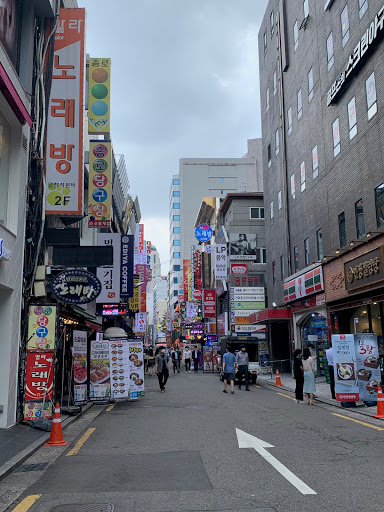


































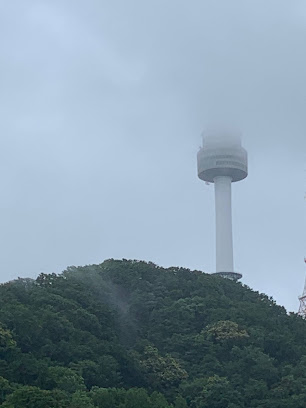

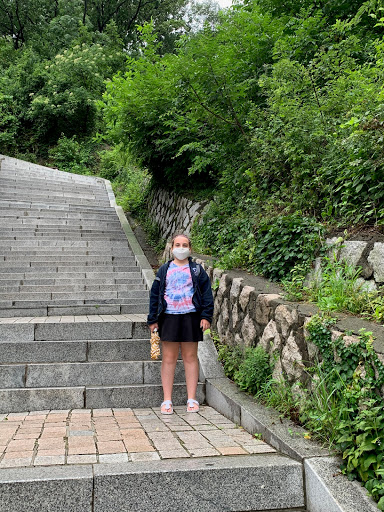































































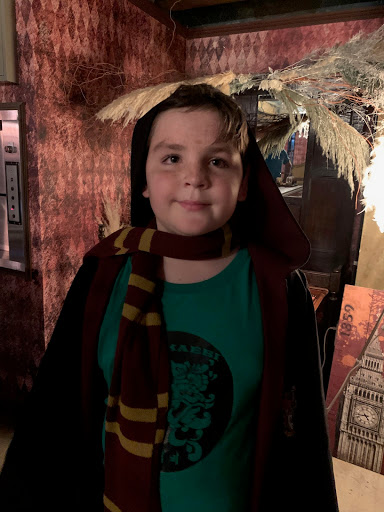



















































































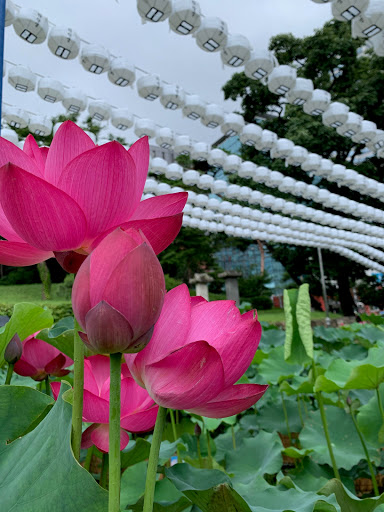

































No comments:
Post a Comment